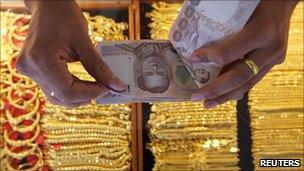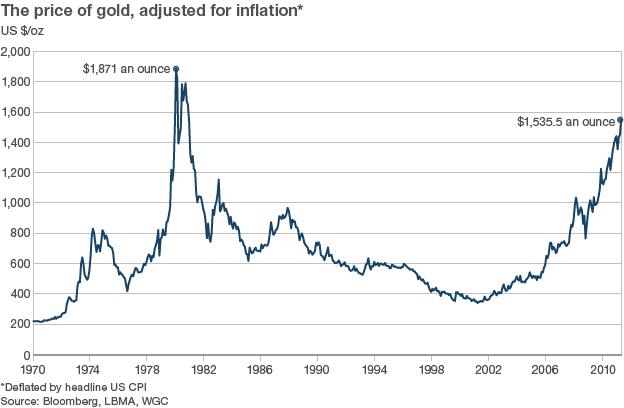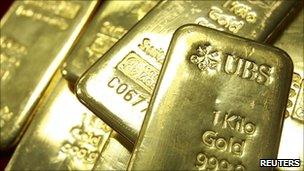Gold rush: All change for the world's favourite metal
- Published

The perception of gold has changed fundamentally in the past ten years
Gold's position as the ultimate storer of value has remained largely unchallenged for centuries.
The metal's rarity not only meant it became a recognised and trusted form of payment, but also bestowed upon it an almost mystical allure.
This came about not through historical accident or coincidence, but for the simple reason that nothing else fitted the bill; almost every other element is either too common, reactive, corrosive or gaseous. And most of those that aren't are just too scarce.
Throughout history emperors, kings and queens, governments, central banks and investors have trusted gold to maintain its value.
This is simply because gold is a physical asset with a finite supply, unlike cash, equities and bonds, which can be printed or issued at will.
For investors, therefore, it has always been seen primarily as a good hedge against inflation - traditionally, few people bought gold to make money, simply to protect themselves against losing it.
Price surge
But all this is changing. Gold has risen in value every year for the past 10 years, during which its price has risen fivefold to more than $1,500 an ounce.
No longer, therefore, is gold seen simply as a way to store value, but as a genuine investment opportunity offering the potential to make a serious return.
But should it be? It is certainly true that all the factors currently driving the price up are likely to continue doing so for the foreseeable future.
Laying aside short-term factors such as unrest in the Middle East and North Africa, and low interests rates making cash unattractive, there are three central drivers behind gold's seemingly unstoppable rise.
First, higher inflation rates driven by monetary easing across the world are making gold - the classic hedge against rising prices - more attractive.
Second, major global currencies - rival safe havens for investors' money - are looking decidedly dodgy.
The US dollar is weakened due to the country's massive debt problem which the government seems unwilling or unable to tackle.
And the euro is undermined by similar issues among the so-called peripheral members.
Finally, economic imbalances between East and West - between the world's savers and the world's spenders - are fuelling a general sense of unease about the future direction of the global economy.
And as one investment manager put it, gold is "the great barometer of uncertainty".
Add to this the increasing demand for gold jewellery from the growing middle classes in India and China, and for gold bars from the central banks of these two emerging powerhouses, as well as long-term production that is unlikely to rise, and you might think gold was not just an attractive investment, but a pretty sure thing.
'Fear trade'
Not so, say a number of analysts.

Growing demand for gold jewellery in developing economies is helping to drive the price of gold up
"It is wrong to see gold as an investment," says Tom Stevenson, investment director at fund manager Fidelity Investments.
"It does not provide an income and is almost impossible to value. The fact that it is has risen in price is not a recommendation to buy; in fact it could be quite the opposite."
He does not expect the price to fall any time soon, largely due to the weak dollar outlook, but warns that, in the long term, the true price of gold must be linked to the cost of its production, which is much less than $1,500 an ounce.
Anything over and above this cost is just speculation, he argues.
In fact, stripping out inflation, the current price of gold is still below its 1980 peak. It would have to hit almost $2,000 to breach that inflation-adjusted record.

Yogi Dewan, chief executive of Hassium Asset Management, agrees.
The current surge in the gold price is based on "speculation and fear trades," he says.
"It's absolutely crazy [for the price] to be at $1,500 - we are clearly in bubble territory."
In fact, Mr Dewan argues that the price may drop sharply once interest rates begin to rise as the global economy continues to recover.
"If rates move significantly, there could be a massive move in price, possibly back towards the $1,100 level," he says.
This is simply because higher rates make cash and currencies more attractive, and signify a return of confidence in the global economy.
Too popular

Central banks in India and China are looking to increase their holdings of gold
Most importantly perhaps, Mr Dewan also argues that gold is now a "crowded trade". In other words, too many people own it - not a characteristic savvy investors look for.
Part of this is due to the remarkable success of gold exchange traded funds (ETF). These are vehicles that allow investors to gain exposure to the gold price without having to own any physical gold.
The largest gold ETF, the SPDR Gold Shares, holds more than $55bn and is one of the largest ETFs of any kind in the world.
In fact these investment vehicles' popularity, along with the recent surge in the gold price, is further evidence for those who argue the price is being driven more by sentiment and speculation than by fundamentals.
It may well be, therefore, that the fundamental change in perception of gold, from storer of value to investment opportunity, could be the very reason to avoid it.

- Published10 May 2011
- Published29 April 2011